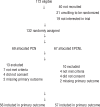Emergency percutaneous nephrostomy versus emergency percutaneous nephrolithotomy in patients with sepsis associated with large uretero-pelvic junction stone impaction: a randomized controlled trial
- PMID: 28128911
- PMCID: PMC5462139
- DOI: 10.1590/S1677-5538.IBJU.2015.0643
Emergency percutaneous nephrostomy versus emergency percutaneous nephrolithotomy in patients with sepsis associated with large uretero-pelvic junction stone impaction: a randomized controlled trial
Abstract
Introduction: A randomized trial was conducted prospectively to evaluate the efficacy, related complications, and convalescence of emergency percutaneous nephrolithotomy compared to percutaneous nephrostomy for decompression of the collecting system in cases of sepsis associated with large uretero-pelvic junction stone impaction.
Materials and methods: The inclusion criteria included a WBC count of 10.000/mm3 or more and/or a temperature of 38°C or higher. Besides, all enrolled patients should maintain stable hemodynamic status and proper organ perfusions. A total of 113 patients with large, obstructive uretero-pelvic junction stones and clinical signs of sepsis completed the study protocol. Of those, 56 patients were placed in the emergency percutaneous nephrostomy group, while the other 57 patients were part of the percutaneous nephrolithotomy group. The primary end point was the time until normalization of white blood cells (WBC) at a count of 10.000/mm3 or less, and a temperature of 37.4°C or lower. The secondary end points included the comparison of analgesic consumption, length of stay, and related complications. Statistical analysis was performed using SPSS® version 14.0.1. The Mann-Whitney U test, chi-square test, and Fisher's exact test were used as appropriate.
Results: The length of hospital stays (in days) was 10.09±3.43 for the emergency percutaneous nephrostomy group and 8.18±2.72 for the percutaneous nephrolithotomy group. This set of data noted a significant difference between groups. There was no difference between groups in regard to white blood cell count (in mm3), time to normalization of white blood cell count (in days), body temperature (in ºC), time to normalization of body temperature (in days), C-reactive proteins (in mg/dL), time taken for C-reactive proteins to decrease over 25% (in days), procalcitonin (in ng/mL), or complication rates.
Conclusions: This study confirms that emergency percutaneous nephrolithotomy may be as safe as early percutaneous nephrolithotomy in a selected low risk patients with sepsis-associated large, obstructive stone.
Keywords: Complications [Subheading]; Nephrostomy, Percutaneous; Sepsis.
Copyright® by the International Brazilian Journal of Urology.
Conflict of interest statement
CONFLICT OF INTEREST
None declared.
Similar articles
-
Percutaneous nephrostomy versus ureteroscopic management of sepsis associated with ureteral stone impaction: a randomized controlled trial.Urolithiasis. 2016 Oct;44(5):415-9. doi: 10.1007/s00240-015-0852-7. Epub 2015 Dec 11. Urolithiasis. 2016. PMID: 26662171 Clinical Trial.
-
Laparoscopic pyelolithotomy compared to percutaneous nephrolithotomy as surgical management for large renal pelvic calculi: a meta-analysis.J Urol. 2013 Sep;190(3):888-93. doi: 10.1016/j.juro.2013.02.092. Epub 2013 Feb 27. J Urol. 2013. PMID: 23454154 Review.
-
A randomized controlled trial of nephrostomy placement versus tubeless percutaneous nephrolithotomy.J Urol. 2008 Aug;180(2):612-4. doi: 10.1016/j.juro.2008.04.020. Epub 2008 Jun 12. J Urol. 2008. PMID: 18554657 Clinical Trial.
-
Randomized controlled trial comparing retroperitoneal laparoscopic pyelolithotomy versus percutaneous nephrolithotomy for the treatment of large renal pelvic calculi: a pilot study.J Endourol. 2014 Aug;28(8):946-50. doi: 10.1089/end.2014.0064. Epub 2014 May 28. J Endourol. 2014. PMID: 24708300 Clinical Trial.
-
Lessons from Literature: Nephrostomy Versus Double J Ureteral Catheterization in Patients with Obstructive Urolithiasis-Which Method Is Superior?J Endourol. 2019 Oct;33(10):777-786. doi: 10.1089/end.2019.0309. Epub 2019 Aug 28. J Endourol. 2019. PMID: 31250680 Review.
Cited by
-
Community Acquired Urosepsis: A surgical intensive care Experience.Qatar Med J. 2020 Apr 2;2020(1):8. doi: 10.5339/qmj.2020.8. eCollection 2020. Qatar Med J. 2020. PMID: 32274352 Free PMC article.
-
Research progress of percutaneous nephrolithotomy.Int Urol Nephrol. 2018 May;50(5):807-817. doi: 10.1007/s11255-018-1847-4. Epub 2018 Mar 19. Int Urol Nephrol. 2018. PMID: 29556901 Review.
References
-
- Amano T, Matsui F, Takashima H, Takemae K. Analysis of patients with septic shock due to urosepsis brought on by ureteral calculi. Hinyokika Kiyo. 2003;49:1–4. - PubMed
-
- Ramsey S, Robertson A, Ablett MJ, Meddings RN, Hollins GW, Little B. Evidence-based drainage of infected hydronephrosis secondary to ureteric calculi. J Endourol. 2010;24:185–189. - PubMed
-
- Lynch MF, Anson KM, Patel U. Percutaneous nephrostomy and ureteric stent insertion for acute renal deobstruction. Consensus based guidelines. Br J Med Surg Urol. 2008;1:120–125.
-
- Türk C, Knoll T, Petrik A, Sarica K, Skolarikos A, Straub M, Seitz C. EUA Guidelines on Urolithiasis. 2015. pp. 21–21. http://uroweb.org/wp-content/uploads/22-Urolithiasis_LR_full.pdf.
-
- Thuroff JW, Gilfrich CP. Percutaneous endourology and ureterorenoscopy. In: Tanagho EA, McAninch JW, eds, editors. Smith’s General Urology. 16. New York: McGraw-Hill; 2000. pp. 121–139.
Publication types
MeSH terms
LinkOut - more resources
Full Text Sources
Other Literature Sources
Medical

